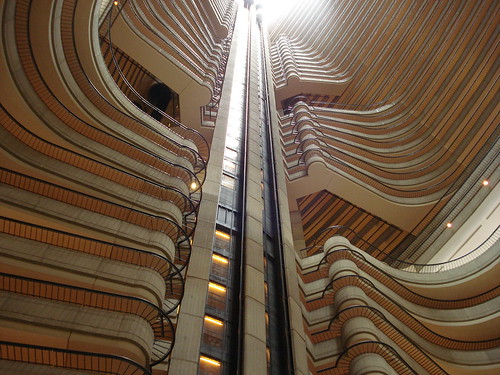
UnBeige informs me that the High Museum of Art has prepared a tribute to John Portman, Atlanta’s ur-architect and greatest claim to urban influence (judgment suspended). The mind reels with metastatic critical possibilities for such a show — Mike Davis on the Bonaventure Hotel, quotations from J.G. Ballard’s High Rise — but one suspects this is not that show. Portman’s own art, typically shown in the lobby of the building that is his portrait, the Marriott Marquis (1985), is on display within the walls of another architect(s) museum. That hotel, seen above via Atelier FLIR, was best described by Rem Koolhaas in SMLXL. A brief excerpt (see page 833ff.):
John Portman is also responsible for single-handedly perfecting a device that spread from Atlanta to the rest of America, and from America to the rest of the world 9even Europe): he (re)invented the atrium.
Since the Romans, the atrium had been a hole in a house or building that injects light an air — the outside — into the center; in Portman’s hands it became the opposite: a container of artificiality that allows its occupants to avoid daylight forever — a hermetic interior, seated against the real…
The new atrium became a replica as inclusive as downtown itself, an ersatz downtown. Downtown’s buildings are no longer complementary; they don’t need each other; they become hostile; they compete…With atriums as private mini-centers, buildings no longer depend on specific locations. They can be anywhere.
And if they can be anywhere, why should they be downtown?
That was Portman’s Paradox.
The rediscovery of downtown quickly degenerated into a proliferation of quasi-downtowns that together destroyed the essence of center.
In other words, after Manhattanism, Portmanism. If Portman hadn’t existed, Koolhaas might have had to invent him, so interested is he in resuscitating the ideas of a certain set of third-tier architects, smart men who went the way of commerce and developed forms that, once copied, they could not control. Wallace K. Harrison falls into this category (see the XYZ Buildings on Sixth Avenue), as well as Victor Gruen, father of the mall, from whom I think Koolhaas derived his now-passed theory of “junkspace.” It is ironic that the only Portman atrium I have actually experienced is not in the land of air-conditioning (much of Portman’s current work is is Asia) but the land of internal combustion, Detroit, where the Renaissance Center (no need to make a joke) sits just one street away from the real downtown, and sucks the life out of it in solitary splendor.
